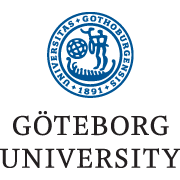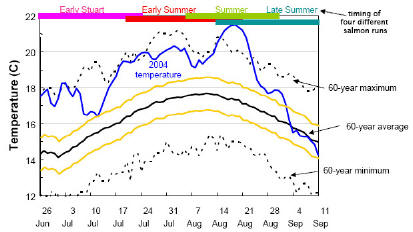 The mission of the Bio-HOPE project
The mission of the Bio-HOPE project
Provide freely-accesible, high quality on-line biology teaching resources for high school/gymnasium and university students that:
- bridge the time limitations imposed by the classroom schedule;
- allow virtual/remote control of equipment unavailable in most classrooms;
- target different learning styles and levels via differentiated instruction and modular design;
- give students direct experience with the scientific method;
- promote inquiry-based learning; and
- support teachers through workshops.
The focus of Bio-HOPE will be to examine the impacts of climate change (global warming) on the migration of salmon in the Fraser river in British Columbia, Canada – the largest salmon producing river in the world.
Through our expertise in fish physiology, microscopy and environmental impacts on organisms, students using our resources will gain an understanding of basic biological principles, the scientific method, and the integration of biological organization from the molecular to the population level.
Students will examine the problem of disappearing Fraser river salmon in the context of an ESI – Environmental Science Investigation.
The members of the Bio-HOPE team
SWEDEN – Göteborg – Linköping
Michael Axelsson – Professor of Comparative Physiology, Department of Zoology, Göteborg University; Bio-HOPE project director
Jordi Altimiras – Associate Professor of Zoology at IFM , Linköping University; Cardiovascular Development Research; curriculum design
Bengt Petersson – Director of Studies in Education, Department of Education, Göteborg University; project evaluation
Tommy Eriksson – Ph.D. candidate, IT University, Göteborg University; Applied IT and Digital Formation; web design and evaluation
STANFORD
David Epel – Stanford University Jane & Marshall Steel Jr. Professor in Marine Sciences, Hopkins Marine Station;
Developmental & cell biology; Bio-HOPE project director
Pam Miller – Hopkins Marine Station and Seaside High School; curriculum design and instruction
Jason Hodin – Hopkins Marine Station; Developmental & invertebrate biologist; curriculum, web & Flash design
Camillan Huang-Voss – Stanford University School of Medicine, Virtual Labs Project Director; technical consultant
| Our sister projects | ||
|
The group at Stanford University’s Hopkins Marine Station is engaged in an NSF-sponsored project entitled VirtualUrchin, focused on teaching basic biological principles to high school students using the sea urchin as an example. |
||
 Stanford University Stanford University |
|
|
|
The groups at Göteborg University and Linköping University are engaged in the InternetBioLab project, which produce remotely-operated on-line physiology laboratories for distance learning University students. |
||
 |
 |
|
Our focus in learning module
Fraser river salmon
In Bio-HOPE, students will investigate what is happening to the most productive salmon river system on the planet, the Fraser River, as a result of a small rise in water temperatures. This river has seen sporadic and precipitous drops in successful spawning events in the last few years, and elevated temperatures and its effects on fish swimming ability appear to be the major cause.
2004 was a particularly bad year for the salmon, when summertime wat er temperatures were higher than they have ever been recorded in the river! In that year, over a million fish disppeared before ever reaching their spawning grounds. As a result, and due to another unusually warm year in 2006, Canadian officials are considering closing the fishery sometime in the near future.
er temperatures were higher than they have ever been recorded in the river! In that year, over a million fish disppeared before ever reaching their spawning grounds. As a result, and due to another unusually warm year in 2006, Canadian officials are considering closing the fishery sometime in the near future.
The environmental impact of disappearing salmon is already potentially devastating, as salmon are key members of both river and ocean ecosystems in the region. The economic impact of such a collapse on British Columbia, and the First Nations peoples that still depend on the river, would be enormous.
To understand the salmon disappearances, students will actively explore salmon life cycles, how to determine the age of salmon, respiration, circulation, migration and energetics, as well as general information on global climate change and its real-world impacts.
The structure of the learning module 1
| Global Warming &
Fraser River Salmon |
Questions & Topics | Activities, virtual & remotely operated learning tools |
| Sub-module 1- Global Warming
Global warming from a scientific viewpoint; complexity, as well as dangers & real world climate change impacts. |
• What is it meant by global warming?
• Scientific data in support for global warming • Specific, real-world examples where global warming can be evidenced • Is there still a controversy? |
• Exploration of linked websites (and lent materials from other sites) documenting global warming
• Scientist interviews & everyday experiences related to global warming – “microdocs” * • Interactive world map with world sites of concern will take students to the scene of the “ESI” – “Environmental Science Investigation” • Animation of river temperature changes |
| Sub-module 2- The Fraser River & Salmon
Fraser River geologic/ hydrologic info, and influences on fish populations. |
• What is the geologic history of the Fraser River?
• Hydrologic information-Fraser River • First Nations use of the Fraser River |
• First Nations-living history interviews
• Interactive timeline-animation of geologic changes in the Fraser River • Illustration of hydrologic changes; virtual digital measurement of steam flow rates with digital probes |
| Sub-module 3- The Physical Environment
Influence of physical environment on fish biology. |
• How does the physics of water influence respiration?
• Ectothermy and endothermy • Comparisons to mammals. |
• Animations and simulations of density, diffusion in salt vs. fresh water, viscosity, and oxygen solubility
• Virtual measurement of temperature, pH & salinity with digital probes |
| Sub-module 4- Fish Populations in the Fraser River
The fish species in the river from estuary to spawning ground. |
• What species are present in the river and when?
• What is the salmon life cycle/migration pattern? • What is the food web in this community? |
• Roll-overs with fish species and data (modeled after VirtualUrchin resources).
• Fish age studies w. virtual microscope/dissecting scopes using otoliths & scales • Fish relatives- DNA sequence analysis in virtual lab • Predator/prey drag & drop activity (a la VirtualUrchin) • Interactive model of the river with adjustable calendar showing presence and movement of fish. |
| Sub-module 5- Respiration in Fish
The anatomy and physiology of respiration in fish contrasted with air-breathing animals. |
• What is the anatomy of the fish?
• How do gills work to obtain oxygen for fish? • How can a small difference have such a dramatic influence on oxygen use? |
• Interactive fish system anatomy study (modeled after VirtualUrchin anatomy resources)
• Countercurrent exchange & Respirometer virtual & remotely controlled labs • Simulation of O2 diffusion and temperature change • Virtual microscope studies of gills, red blood cells, & RBC movement through capillaries • Interactive O2/CO2 dissociation curves (a la SYMPHYSIO) |
| Sub-module 6- Cardio-vascular Physiology
Anatomy/function of fish cardiovascular system compared to mammals. |
• What are the adaptations of the fish cardiovascular system?
• What are the limitations, (coronary circulation, respiratory system, power generation) of the heart? |
• Interactive model of the fish cardiovascular system (modeled after VirtualUrchin anatomy resources)
• Effects of temperature on cardiac activity • Models of the hemodynamics of blood flow • Video sequences of the working heart at different workloads and blood flow though various regions |
| Sub-module 7- Exercise Physiology
The different swimming modes in fish species and comparisons with human physical exercise challenges. |
• How does the fish muscle system support swimming?
• What are the demands of swimming upstream? • How can we measure swimming capacity? • How do the physical properties of water relate to fish’s cardiovascular needs? |
• Scientists videos (Tony Farrell, Barbara Block) – exercise physiology, real swim tunnel studies
• Interactive adjustable thermometer linked to videos of salmon swimming in tunnel • Virtual microscope studies of fish muscle tissue • SYMPHYSIO animation adaptations comparing human runner/mountain climber & fish swimming • Counter-current Exchange and Respirometer virtual and remote controlled labs |
| Sub-module 8- Effects of Climate Change on the Frasier River
Facing the problems of reduced salmon migration success. |
• Why are fewer salmon successfully migrating in the Fraser River?
• How large a change in emissions is required to reverse the trend? |
• Simulation of CO2 levels and temperature correlations
• Simulation showing human lifestyle choices and correlation to CO2 levels • Student hypotheses, testing your choices, results shown as increasing Fraser fish populations. |
| *These video clips will be modeled after the conservation “microdocs” developed by our colleague at Hopkins Marine Station, Dr. Steve Palumbi. Indeed, Dr. Palumbi will allow us to use any microdoc videos on our site that would be appropriate for our teaching modules | ||
